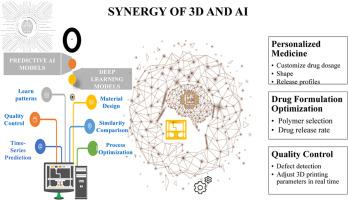ai驱动的医药3D打印转型:提高精度、效率和个性化
Q1 Computer Science
引用次数: 0
摘要
云计算技术、物联网系统和人工智能(AI)为制药3D打印带来了重大变化,促进了药物设计、制造和个性化药物交付的新机遇。通过人工智能进行的算法处理改进了药物的计算建模,预测了配方的稳定性,并实时检测了打印剂型的缺陷,同时提高了操作效率。机器学习系统有助于优化打印设置,以实现一致的结果,并减少生产批次的材料浪费。人工智能在制药3D打印中的应用需要克服三大挑战:监管障碍、标准和数据隐私问题。为了克服这些问题,监管机构、制药研究人员和技术公司必须合作制定制药数据保护标准以及合规框架。人工智能驱动的软件解决方案采用预测分析进行实时质量控制,减少了制造故障的数量。本文讨论了监管障碍、数据安全问题和标准。此外,确定研究差距,以便学者可以继续研究基于人工智能的3D打印模型。人工智能的应用使制药公司能够提高运营效率和精确能力,以及创新开发,从而在现代生产方法的同时,为个体患者调整先进的药物疗法。本文章由计算机程序翻译,如有差异,请以英文原文为准。

AI-powered transformation of pharmaceutical 3D printing: enhancing precision, efficiency, and personalization
Cloud computing technologies and Internet of Things systems and artificial intelligence (AI) have brought major changes to pharmaceutical 3D printing by promoting new opportunities in designing drugs and manufacturing and personalized medicine delivery. Algorithmic processing through AI improves the modeling of drugs for computation and predicts formulation stability and detects real-time defects in printed dosage forms while boosting operational efficiency. Machine learning systems help optimize printing settings to achieve consistent results and reduce material waste across production batches. The use of artificial intelligence in pharmaceutical 3D printing needs overcoming three major challenges: regulatory hurdles, standards, and data privacy concerns. To overcome these problems, regulatory authorities, pharmaceutical researchers, and technology companies must collaborate to set standards for pharmaceutical data protection as well as compliance frameworks. AI-powered software solutions employ predictive analytics to do quality control in real time, reducing the amount of manufacturing failures. This article discusses regulatory obstacles, data security issues, and standards. Furthermore, identify research gaps so that academics can continue to work on AI-based 3D printing models. The application of AI enables pharmaceutical companies to boost operational efficiency and precision capabilities as well as innovative developments that lead to advanced drug therapies adjusted for individual patients alongside contemporary production methods.
求助全文
通过发布文献求助,成功后即可免费获取论文全文。
去求助
来源期刊

Bioprinting
Computer Science-Computer Science Applications
CiteScore
11.50
自引率
0.00%
发文量
72
审稿时长
68 days
期刊介绍:
Bioprinting is a broad-spectrum, multidisciplinary journal that covers all aspects of 3D fabrication technology involving biological tissues, organs and cells for medical and biotechnology applications. Topics covered include nanomaterials, biomaterials, scaffolds, 3D printing technology, imaging and CAD/CAM software and hardware, post-printing bioreactor maturation, cell and biological factor patterning, biofabrication, tissue engineering and other applications of 3D bioprinting technology. Bioprinting publishes research reports describing novel results with high clinical significance in all areas of 3D bioprinting research. Bioprinting issues contain a wide variety of review and analysis articles covering topics relevant to 3D bioprinting ranging from basic biological, material and technical advances to pre-clinical and clinical applications of 3D bioprinting.
 求助内容:
求助内容: 应助结果提醒方式:
应助结果提醒方式:


